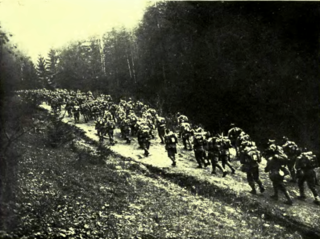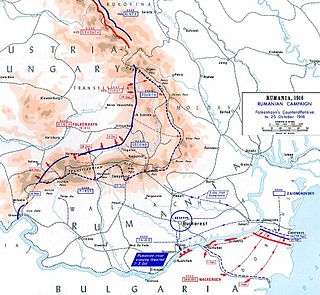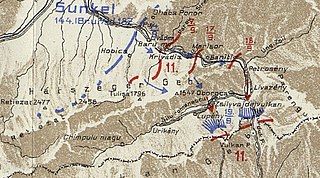
The Battle of Prunaru was a military engagement between German and Romanian forces during the Romanian Campaign of World War I. It resulted in a tactical German victory, but following the heavy Romanian resistance the Germans halted after taking Prunaru. General Constantin Prezan's maneuver group checked the German forces in the region within two days, exposing the left flank of Field Marshal August von Mackensen's Danube Army.

The Battle of Transylvania was the first major operation of Romania during World War I, beginning on 27 August 1916. It started as an attempt by the Romanian Army to seize Transylvania, and potentially knock Austria-Hungary out of the war. Although initially successful, the offensive was brought to a halt after Bulgaria's attack on Dobruja. Coupled with a successful German and Austro-Hungarian counterattack which started in mid-September, the Romanian Army was eventually forced to retreat back to the Carpathians by mid-October. The Romanian armies however managed to escape the Central Powers' attempts to completely destroy them. The Battle of Transylvania also caused the replacement of the Chief of Staff of the German Army and the shifting of German attention to the region, causing German offensive operations at Verdun to cease.

Ioan Culcer was a Wallachian-born Romanian military leader and politician. Culcer served as a lieutenant during the Romanian War of Independence (1877–1878) and as a general during the Second Balkan War and World War I. In early 1918, he served as Minister for Public Works in the First Averescu cabinet.

The Orsova Offensive was a military engagement fought between the armies of Romania and Austria-Hungary at the start of the Romanian Campaign in August–September 1916. It ended in a Romanian victory which led to the Romanian occupation of the west bank of the Cserna (Cerna) River for over two months.
The Battle of Báránykút was a military engagement during the Battle of Transylvania, at the beginning of the Romanian Campaign of World War I. It consisted in a German offensive that was successfully repulsed by the Romanians, who then carried out a largely unhindered tactical retreat.

The Battle of Dragoslavele was a military engagement fought between Romanian forces on one side and Central Powers forces on the other. It was part of the Romanian Campaign of World War I. The battle resulted in a Romanian victory and the effective end of Central Powers advances in the area.

The Battle of the Southern Carpathians was a major operation during the Romanian Campaign of World War I. The brainchild of German General Erich von Falkenhayn, the operation consisted in an attempt by the Central Powers to assault all of the passes in the Southern Carpathians at the same time, and exploit a success wherever it might have come. However, this did not happen, as Romanian defenses could not be defeated in any of the five areas that Falkenhayn's spread-out army tried to force.

The Romanian Debacle consisted in a series of battles between November and December 1916 which led to the Central Powers conquest of Bucharest, the capital of Romania. Russian forces joined the Romanians at the start of December.

The Pitești–Târgoviște Retreat was a fighting-withdrawal operation carried out by the Romanian 1st Army in the face of advancing Central Powers' forces during World War I. The retreat lasted from 29 November to 3 December and culminated in a violent battle at Târgoviște, after which the entire Romanian Army started a general retreat towards Moldavia.

The Battle of the Eastern Carpathians consisted in a series of military engagements between Romanian and Austro-Hungarian forces during October 1916, in World War I. The attempt of the Austro-Hungarian 1st Army to break through the Eastern Carpathians was simultaneous with that of the German 9th Army to force the passes of the Southern Carpathians. Both efforts failed.

The Battle of Mezőlivádia was a military engagement fought between Romanian and Central Powers forces during the Romanian Campaign of the First World War. It was part of the Battle of Transylvania. This battle is notable for being the first Central Powers counterattack against the Romanian invasion of Transylvania, as well as the first military engagement during the Battle of Transylvania to involve German forces. The battle resulted in a Romanian victory.

The Second Battle of Petrozsény was a World War I military engagement between Romanian forces on one side and Central Powers forces on the other side. It was part of the wider Battle of Transylvania and resulted in a Romanian victory.

The Battle of Nagybár was a military engagement between Romanian forces on one side and Central Powers forces on the other side. It was part of the 1916 Battle of Transylvania during the Romanian Campaign of World War I. The battle resulted in a Romanian victory.

The Battle of Herkulesfürdő was a military engagement during the Romanian Campaign of World War I. It was fought between Romanian forces on one side and Central Powers forces on the other side. It resulted in a Romanian victory.

The Petrozsény Offensive was the opening action of the south-western front of the 1916 Battle of Transylvania, during World War I. The Transylvanian coal-mining center of Petrozsény (Petroșani) was occupied by the Romanian Army on 29 August, two days after the Kingdom of Romania declared war on Austria-Hungary.

The Third Battle of Petrozsény was a World War I military engagement between Romanian forces on one side and Central Powers forces on the other side. It was part of the wider Battle of Transylvania and the last engagement in the area around Petrozsény. The battle resulted in a Central Powers victory.

The Battle of Sellenberk was a World War I military engagement fought between Romanian forces on one side and Central Powers forces on the other side. It was part of the wider Battle of Transylvania and resulted in a Romanian victory.

The Veresmart Offensive was a World War I military engagement between Romanian forces on one side and Central Powers forces on the other side. It was part of the larger Battle of Transylvania. Although the Romanians failed to reach their planned objective, the strategic situation of the Central Powers was significantly worsened by the Romanian attack. Nevertheless, the Romanian forces did not exploit their strategic success further.

The Battle of Nagyszeben was a World War I military engagement fought between the forces of the Central Powers on one side and the forces of Romania on the other side. It was the decisive engagement during the Battle of Transylvania, and also the largest, involving four armies out of the five fighting in the region: two Romanian, one German, and one Austro-Hungarian.

The Battle of Kolun was a World War I military engagement fought between Romanian and Central Powers forces. It was part of the wider Battle of Transylvania and resulted in a tactical victory for the Central Powers.


















